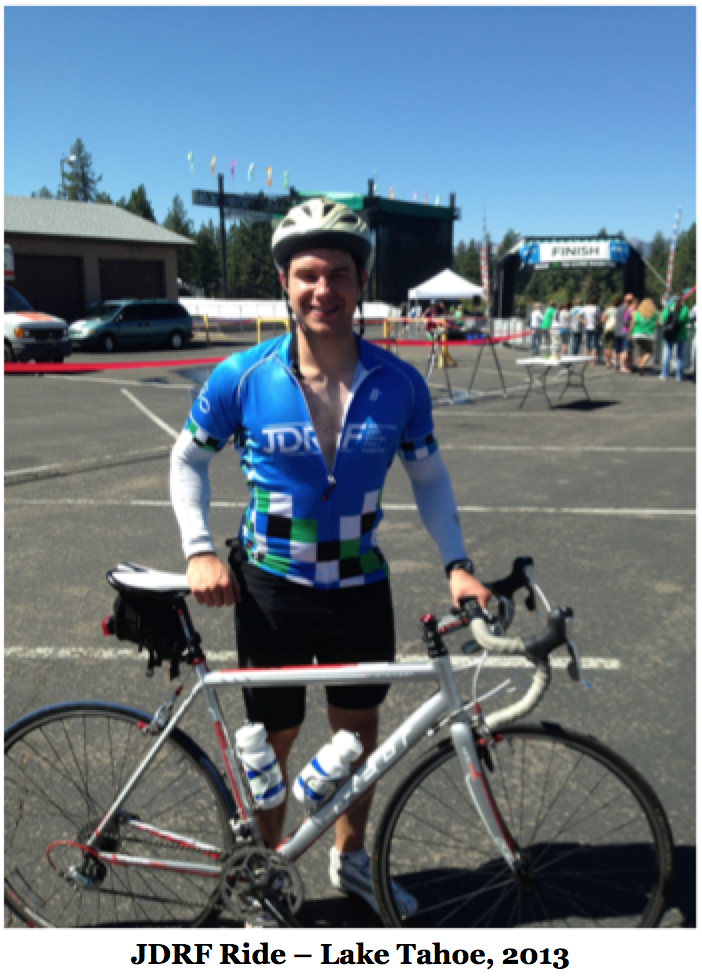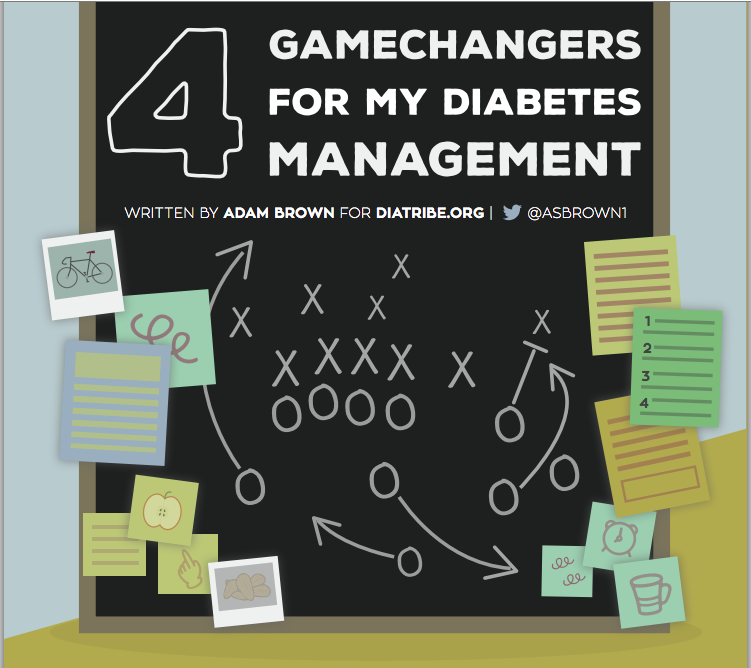Getting to Goal – The Four Biggest Game-changers for Improving My Diabetes Management
By Adam Brown
 by Adam Brown
by Adam Brown
view an infographic summary of this article
twitter summary: The four biggest #gamechangers for improving my #diabetes management: eating low carb, exercise, using CGM, getting more educated
When I was a teenager, I consistently ran an A1c in the 8.0%-9.0% range, spending a significant percentage of the day both hyperglycemic and hypoglycemic. At the time, I didn’t truly grasp the implications of such careless management – I just wanted to eat pizza, sleep late, and be a normal adolescent! But in college, something clicked after taking several nutrition classes, having a bodybuilder as a roommate, and working at diaTribe. Since then, I’ve consistently had an A1c under 7% and have spent a much larger portion of my day in an ideal blood glucose range. Reflecting back, I immediately thought of four critical inflection points. I recognize these may not be right for everyone, but I thought it might be useful to share them:
1. Eating low-carb and low-glycemic foods: This is very controversial in the diabetes community, but I personally became a huge, huge fan of following a low carb/low glycemic diet in college. Here’s why:
-
Wider margin for error – I take much smaller doses of insulin (usually one to three units per meal), meaning my blood sugar is less susceptible to errors in carb counting, changes in insulin sensitivity, infusion set failures, etc.
-
Smaller glycemic excursions – When I do get it wrong, I’m generally correcting a 150 mg/dl instead of a 350 mg/dl.
-
Less risk of insulin stacking/insulin on board – Since I’m using smaller quantiti
 es of insulin, the risk of hypoglycemia is diminished.
es of insulin, the risk of hypoglycemia is diminished.
If every dose of insulin is like firing at a target, I have found that eating low carb is like using a bow and arrow instead of a cannon: it’s more precise, more tactical, and there’s less potential for damage. I recognize this approach is not for everyone. It takes some getting used to, and I’m the first to admit that it does come with some inconveniences (cost, prep time, finding options at restaurants, occasional challenges in group eating settings). But for me, the overall benefits of tighter control outweigh the drawbacks.
2. Exercising and staying very active: I was diagnosed at age 12. At the time, I took exercise for granted, as I was on several sports teams. But as I’ve gotten older and these organized activities have faded, staying active has required more effort and discipline. Still, I cannot overemphasize what a complete gamechanger exercise has been (and still is) for my diabetes management. I do a mix of strength training (weights) and cardio (cycling); the combo keeps things interesting, gets me outside, and can be transported when I travel. I also wear a Fitbit activity tracker to ensure I get enough general movement every day (my goal is 10,000 steps), along with engaging with Insulindependence (an organization focused on diabetes and exercise) and Strava (my favorite app for tracking cycling and running). Just a few of the reasons exercise has proven critical for me:
-
Higher insulin sensitivity – On days when I fail to exercise, I need much more insulin (basal and bolus), and my glycemic spikes tend to be higher.

-
An insulin alternative – Often, I can use exercise instead of taking insulin to correct a high. For example, I can drop a blood glucose level of 150 mg/dl with a long walk instead of 1.5 units of insulin. I find that coupling a bolus insulin dose with light exercise means I need about half as much, and adding hard exercise to a bolus insulin dose means I need only a quarter as much (i.e., one unit instead of four units).
-
More energy – It’s counterintuitive, but on days when I exercise, I actually have more energy than on days when I’m not active.
-
Stress relief and general happiness – Perhaps even more than the glycemic benefits, exercise is critical for reducing my stress levels and making me a happier and more positive person. Given the stress, burden, stigma, and worry that diabetes causes, I’ve found that exercise is the ultimate prescription for dealing with the mental and emotional toll of diabetes.
3. Using continuous glucose monitoring (CGM): I didn’t truly grasp the impact of certain meals or the slow speed of insulin until I could see my glucose changing in real time with CGM. (The real-time component also ties in well with tip #1.) This one device has been a total and complete gamechanger for me, helping me cut off both highs and lows during the day and at night. In fact, I’m so used to the continuous data that I feel completely naked when I have to go without it, even for a just a few hours. I’ll acknowledge, of course, that wearing CGM is more expensive than just using fingersticks alone, and that I’m lucky to have access to insurance (I actually first tried CGM when I was a summer intern at diaTribe in 2010!), but the device has kept me out of the hospital many times in the past few years. Insulin, though life saving, is also one of the world’s most dangerous drugs, and CGM gives me a priceless security blanket.
-
For those not on CGM:
.png) You can see our test drives of the Medtronic Enlite and Dexcom G4 Platinum systems here and here, and you can ask your healthcare provider about wearing a CGM for a week (“diagnostic” or “intermittent” use); both Medtronic and Dexcom have return policies if you don’t like it. But trust me – once you experience it, you won’t remember what life was like before it. Your healthcare provider may have to write some letters to your insurance if you are lucky enough to have insurance, but beg them!
You can see our test drives of the Medtronic Enlite and Dexcom G4 Platinum systems here and here, and you can ask your healthcare provider about wearing a CGM for a week (“diagnostic” or “intermittent” use); both Medtronic and Dexcom have return policies if you don’t like it. But trust me – once you experience it, you won’t remember what life was like before it. Your healthcare provider may have to write some letters to your insurance if you are lucky enough to have insurance, but beg them!
4. Getting more educated: Benjamin Franklin’s often-cited quote, “An investment in knowledge pays the best interest,” has rung incredibly true for me with diabetes. I’ve had the privilege of thousands of hours of diabetes education here at diaTribe, and yet, I continue to learn brand new things every day. The volume of knowledge is truly vast, but I always get enormous value from small tips from experts and fellow patients. The education I received at diagnosis was a smidgeon of everything needed to optimally manage diabetes. Here are some resources I have found most useful – some are diabetes specific, while some are more general:
-
Educational Websites: diaTribe, American Association of Diabetes Educators (AADE), American Diabetes Association (ADA), JDRF, National Diabetes Education Program, NIDDK.
-
Online Communities (sometimes the best learning comes through trial and error from patients themselves!): Children with Diabetes, Diabetes Daily, TuDiabetes
-
Diabetes Books: Think Like a Pancreas, Pumping Insulin, Diabetes Burnout, Diabesity
-
Nutrition/Wellness Books: Why We Get Fat, The Four Hour Body, The Paleo Diet, The China Study, The Blue Zones
-
Movies: Food Inc., Fed Up, Super Size Me
Eating low carb, exercising, using CGM, and getting more educated – those were the four biggest gamechangers for improving my diabetes management. Please write to me with yours!








